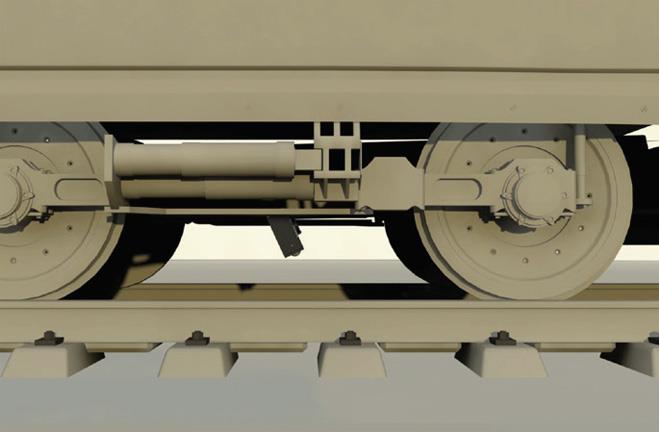The demands for safer rail vehicles that are capable of higher speeds and carrying greater loads means that when it comes to the design, maintenance and modification of vehicles and the rail network itself, the challenges associated with these vastly complex systems can be immense.
The problems that have come to light with the construction of Crossrail in London have highlighted the enormity and complexity associated with these types of projects, not only in developing new trains and stations, but with rolling out new signalling systems, supporting software integration, control systems and then getting them to work together seamlessly.
Simulation tools are being used extensively to test all manner of systems across the Elizabeth Line. For example, the ventilation system has been designed to address various safety and compliance purposes in order to meet normal operations, maintenance and emergence situations.
Testing has been critical to this and a dedicated testing tunnel ventilation control system test suite has been used to mimic live operations.
Beyond this particular project, however, the rail industry also has to contend with much broader trends such as autonomous solutions and electrification.
When it comes to autonomous systems engineering, the focus tends to be on adapting rolling stock that were originally designed for human operators.
As for electrification, these systems tend to be lighter and easier to control than more traditional mechanical systems.
The growing use of electrification often requires a complete re-design of power systems and the need to replace legacy systems too, and that requires engineers to redesign systems safely, quickly and to budget.
ANSYS develops and markets software that can be used to simulate engineering problems.
The company’s SCADE and medini solutions are used for reliable and standards-compliant development, verification and automatic code generation of safety-critical systems and software applications across industry sectors, including the railways.
These solutions help to create models of structures, electronics and components to emulate, for example, their strength, elasticity, EMI and temperature. The company’s software is used to show whether a product will function in the real world while meeting different specifications and addressing various industry standards.
Crucially, all this can be achieved without the need and expense of building a functioning prototype.
According to Günther Siegel, VP Engineering at ANSYS, “Electrification, as well as growing autonomy, are driving the need for more safety critical solutions and, irrespective of sector, companies are faced with the same set of challenges.”
|
“Simulation also has a key role to play in training, not only in making it more relevant but because it is easily repeatable.” Günther Siegel |
Both testing and validation, using simulation, are critical and the tools industry is investing heavily in creating more innovative simulation platforms.
“By using simulation software engineers can ensure that all electrical, mechanical and software control systems can interact safely and optimally, especially early on in product development cycles and without the need of having to invest in a physical prototype,” Siegel explains.
Simulation can help to solve a broad range of multi-physics and multifunctional performance issues quickly, which is becoming increasingly important as designers have to meet more aggressive development cycles.
For example, ANSYS has a model-based embedded software development and simulation environment with an automatic built-in code generator that helps to accelerate embedded software development projects.


|
Autodrive Solutions has developed a radar positioning system (RPS) that deploys clusters of plastic bars along railway tracks; different sized bars represent a digital ‘0’ or ‘1’ which are then read by an RPS unit |
“Our SCADE solution enables system and software engineers to graphically design, verify and generate critical systems and applications with high dependability requirements,” says Siegel.“They are interoperable and easily integrated and have been certified to EN50128 up to SIL3/4 when it comes to rail transportation.”
Intended for model based systems engineering, embedded control software development, virtual systems prototyping and functional safety analysis, SCADE can significantly speed up the design process, “by as much as 50 percent, on average, while aligning the design process to safety standard objectives which is critical when it comes to the rail industry,” suggests Siegel.
Focus on rail
While the issue of autonomy might not seem obvious, in relation to the rail industry, the use of autonomous systems is becoming increasingly important as the industry looks to determine accurately where trains are on a network, especially when they need to stop accurately at stations deploying platform screen doors, for example.
The cost of stopping a train automatically can be expensive, it requires continuous calibration as each train will need a different braking process – the number of carriages will vary, as will weight and the subsequent wear on the wheels.
A Spanish company, Autodrive Solutions, has developed a radar positioning system (RPS) that deploys clusters of plastic bars along railway tracks. The different sized bars represent a digital ‘0’ or ‘1’ which are then read by an RPS unit attached to a train to provide an accurate measurement of speed, which is then used to apply a customised breaking process.
To avoid imperfect code causing product failures, the company used SCADE to graphically design, verify and automatically generate applications and as a result was able to save 80 per cent in development time to get the product to market.
Simply by focusing on the model and letting SCADE develop certifiable software to control the hardware that they had developed, if a problem was found during testing all that was needed was to change the model.
SCADE was able to take the model then generate the code with a certified KCG compiler to provide the necessary traceability and documentation needed by the various certification authorities.
Once certified companies can then sell their technology to the wider market.
Currently, ANSYS is helping Poland’s Rail Mil to speed up the development of their embedded software to aid them in developing a fully CBTC class automatic train control system for the Polish Railway transportation sector.
The system will be the first system with such functionality put into operation in Poland. One of the main goals is to achieve the shortening of train headway with no regression for the safety level of the overall system, which is especially important in agglomeration zones i.e. where there is a lot of traffic on the network.
This communication-based train control system is intended to increase railway system capacity while maintaining existing safety levels.
“As industries continue to be impacted by the advancements in technology, organisations must strive to keep up with these changes and use new technologies to deliver better services.
“Of course, one of the main technological drivers in transport is autonomy, but this isn’t new. In the rail industry, autonomous trains are already being used across the world. Instead, the industry needs to focus on intelligent software,” explained Slawomir Jasinski, CEO Rail-Mil Computers.
“We are currently developing what will be the first communication-based train control system of its type in Poland and the support of ANSYS has been critical in supporting this business initiative.
“Compliance is a key challenge for the industry. Regulations require rail companies to implement comprehensive safety measures to ensure rail travel is safe.
“As we develop onboard systems for trains, the intelligent solutions we use have to be reliable and safe, as any issue could lead to serious consequences. We used SCADE to speed up embedded software development and ensure that we were compliant with EU regulations,” explained Jasinski.
Safety is critical but beyond testing Siegel makes the point that the user also needs to be kept ‘in-the-loop’.
“When you are addressing new technology, while testing is crucial, you need to bring innovation to the user and ensure that they are trained and that they remain in control,” he explains.
“You have to ensure that the embedded software that has been used in testing, for example, is exactly the same when it is deployed on a train or in a plane. That really is the key to the successful roll-out of a project.”
Safety is paramount when it comes to public transport, but users need to be fully aware of any changes and improvements that are made to software, an issue for many manufacturers and highlighted by recent aviation disasters.
“Simulation has a key role to play in training not only in making it more relevant but because it is easily repeatable so that the users will be able to maintain their skills and capabilities,” he concludes.












